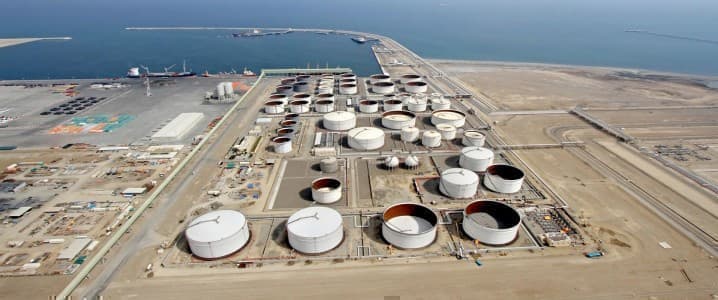Despite the continued bearish sentiment, oil markets saw a bit of support over the past week, resulting from the sharp decline in the crude oil inventories as reported by the EIA. Last Thursday, prices Brent hit its highest level since March at $43.23, closing at $42.78, up by 4.11% w/w, while WTI closed at $40.32, up by 4.54% w/w, with a spread of $2.46 which narrowed by $0.07 w/w.
Bullish data from the U.S. oil sector
U.S. commercial crude inventories declined by 7.20 million barrels w/w, standing at 533.5 million barrels while the U.S. SPR attracted 1.7 million barrels w/w standing at 655.4 million barrels. Crude input to U.S. refineries rose by 0.193 mbbl/d w/w reaching 14.03 million bbl/d, refinery runs remain 3.26 million bbl/d lower than they were last year in June. U.S. oil production remains unchanged at 11 million bbl/d, due to the drop in drilling activity. On the other hand, the EIA report did show some bearish data as gasoline stocks rose by 1.2 million barrels which counters the usual seasonal demand behaviour in the summer and that added more pressure on prices.
Furthermore, the EIA estimates current US oil demand to have risen to more than 18 million bbl/d from less than 14 million bbl/d in April compared with an average of 20.01 million bbl/d last January.
Improved macroeconomic data
Adding to the bullish news, the euro-zone’s economic sentiment rose to 75.7 points this month from 67.5 in May, while all key sectors of the economy in the region showed signs of recovery, which is especially observed in retail trade and services. US labor statistics also reflected additional optimism as the rate of unemployment declined 11.1%, according to the Bureau of Labour Statistics. In China, factory activity has increased to the highest level Since March, as PMI figures rose, by 0.3, to 50.9 compared with forecasts of 50.4. Related: Oil Price Crash Causes Major Recession In Russia
In the previous week, the drop in prices was not only driven by resurgence of COVID-19 cases in several countries, but also poor refining margins, the resumption of U.S. oil production, and remaining high inventories compared to their 5-year average levels. Current COVID-19 cases have exceeded 11 million confirmed cases with the U.S., India, and Brazil battling to contain the outbreak of the disease. We expect the war between positive economic data and Covid-19 cases is likely to persist in the next few weeks as the demand picture continues to unfold.
Improved signs of compliance from OPEC+
Meanwhile, OPEC+ compliance to its output cut deal is said to have exceeded 100% for the month of June according to data from Energy Intelligence, despite some producers falling behind their targets, mainly Iraq, Nigeria and Angola. The 100% compliance is believed to have been achieved in June due to extra voluntary cuts from Saudi Arabia and other GCC producers. The Iraqi oil minister was quoted for holding negotiations with companies on oil contracts for fields with high operating costs. This will reduce expenses when cutting oil production leading to enhanced compliance. Compliance for Iraq, nonetheless, is said to be at 100% in June according to data from Energy Intelligence. The problem with Iraq is that it pays companies to invest in its oil industry so it needs to compensate investors for cutting production at low oil prices.
Currently the West African compliance remains a challenge for the group cohesion. According to data from Energy Intelligence, compliance in June is seen at 68%, for Angola, 15% for Congo, 80% for Nigeria, and 31% for Equatorial Guinea. Angola, in particular, is said to be unable to compensate for its missed targets until Q4 this year. According to OPEC data, Angola has produced 1.28 million bbl/d in May, 100 thousand bbl/d above its target, and it reduced this to 1.24 million bbl/d in June, which is still 60 thousand bbl/d above its target, according to data from Reuters.
Saudi Arabia, which achieved a compliance level of 140%, is said to have averaged a production of 7.49 million bbl/d in June, compared with 12 million bbl/d in April, according to a statement by the CEO of Saudi Aramco. Both the UAE and Kuwait have followed Saudi Arabia in compliance levels with 120% for UAE, and 112% for Kuwait, in the month of June. Furthermore, Kazakhstan is said to have achieved its compliance commitment for the month of June with a production of 1.297 million bbl/d according to official sources. Kazakhstan will continue to over-comply to compensate for its missing targets in May by making additional cuts between July-September. Related: Saudi Arabia Hikes Oil Prices For The Third Consecutive Month
In the meantime, Saudi Arabia and Kuwait restarted production in the joint neutral zone last week, which has a production capacity of more than 500 thousand bbl/d, 300 thousand in Khafji and 250 thousand bbl/d in Wafra. We expect the resumption of production to be a signal of easing current OPEC+ cuts which is set to ease next August to 7.7. million bbl/d, from a current level of 9.6 million bbl/d.
Furthermore, the Libyan National Oil Corporation has indicated that its oil production could return to normal levels following a potential agreement on a new oil revenue distribution mechanism among conflicting armed forces. That may remove the current barriers to restarting production, the security of personnel, which if guaranteed will enable resumption of full production. Libyan crude is of a light sweet type, which historically has been in high demand by Mediterranean refiners which increased their imports from West Africa amid the Libyan blockade of exports.
Our data revision and forecast
The average monthly price for Brent in June was 40.78, $0.78 above our forecast, while WTI averaged 38.33, $3.33 above our forecast. We continue to see an average price of $43 and $38 for Brent and WTI, respectively, throughout July.
Furthermore, our demand forecast for the year 2020 has been raised by 9.76 million bbl/d, to average 90.35 million bbl/d. We see average demand in Q3 standing at 92.33 million bbl/d, compared with an average demand of 79.33 million bbl/d in Q2. This is a 9.99 million bbl/d year-on year reduction. Demand in Q4 is seen to rise to an average of 94.33 million bbl/d, yet down by 6.41 million bbl/d y/y.
By Yousef Alshammari for Oilprice.com
More Top Reads From Oilprice.com:








































